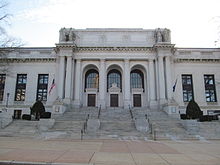User:JPRiley/Hapgood
| This is not a Wikipedia article: It is an individual user's work-in-progress page, and may be incomplete and/or unreliable. For guidance on developing this draft, see Wikipedia:So you made a userspace draft. Find sources: Google (books · news · scholar · free images · WP refs) · FENS · JSTOR · TWL |
Melvin T. Hapgood | |
|---|---|
| Born | February 11, 1859 |
| Died | December 27, 1994 (aged 135) |
| Nationality | United States |
| Occupation | Architect |





Hapgood & Hapgood was an American architectural firm active, under different names, in Hartford, Connecticut from 1885 to 1915. From 1893 to 1899 it was the partnership of cousins Melvin H. Hapgood FAIA (1859–1899) and Edward T. Hapgood AIA (1866–1915).
History and partners[edit]
Hapgood & Hapgood had its origins in the practice of John C. Mead (1840–1889), an architect and builder based in Hartford. Projects completed by Mead include the First Church of Christ, Congregational (1869) in Suffield and Footguard Hall (1888) in Hartford. From 1882 to 1885 his designer was Melvin H. Hapgood:
Melvin Hathaway Hapgood was born February 11, 1859 in Boston to John Gilman Hathaway. He was educated in the public schools, graduating from Charlestown High School in 1877 and thereafter joining the office of William G. Preston. He received his architectural education in Preston's office and in night courses at the Massachusetts Normal Art School and the Lowell Institute drawing school. In 1880 he traveled in Europe before returning to Preston in Boston. In 1882 he left Boston to join Mead as his designer, remaining for three years. In 1885 he opened his own Hartford office. In 1890 he was married to Mary Morgan Smith, daughter of James Allwood Smith.
When Mead died in 1889, he left his business with his superintendent, Charles C. Cook. On January 1, 1890 Cook and Hapgood merged their practices to form Cook, Hapgood & Company, architects and builders. On May 1, they were joined in partnership by Hapgood's cousin, Edward T. Hapgood:
Edward Thomas Hapgood was born December 8, 1866 in Ossining, New York to Thomas Edward Hapgood. He was educated at Dr. Holbrook's Military School and the Metropolitan Museum of Art Schools before joining the New York City office of architect George Martin Huss as a student in 1886. In 1889 Hapgood opened an architect's office of his own and developed a practice chiefly focused on suburban homes in New Jersey and Connecticut. Hapgood's early works include the Congregational Church of Ludlow (1892) in Ludlow, Vermont. In 1892 he was married to Elizabeth Smith of Hartford, a relative of Melvin H. Hapgood's wife, and in 1893 joined his cousin in business in Hartford.
Cook withdrew from the partnership on June 1, 1893, and the cousins continued the practice as Hapgood & Hapgood, architects. Together they developed Hartford's most successful architectural firm. Melvin H. Hapgood died suddenly on July 4, 1899, and the practice was continued by Edward T. Hapgood alone.
Architectural works[edit]
Melvin H. Hapgood, 1885–1890[edit]
- Simsbury Free Library, 749 Hopmeadow St, Simsbury, Connecticut (1889)[1]
Edward T. Hapgood, 1889–1893[edit]
- Congregational Church of Ludlow, 48 Pleasant St, Ludlow, Vermont (1892, NRHP 2004)[2]
- YMCA, 160 Jewell St, Hartford, Connecticut (1893, demolished 1974)[3]
Cook, Hapgood & Company, 1890–1893[edit]
- North-West School, 1240 Albany Ave, Hartford, Connecticut (1891, NRHP 2010)[4]
- Erwin Home for Worthy and Indigent Women, 140 Bassett St, New Britain, Connecticut (1892, 1894 and 1914, NRHP 2002)[5]
- Middletown Municipal Building, Main St, Middletown, Connecticut (1895, demolished 1961)[6]
Hapgood & Hapgood, 1893–1899[edit]
- Esperanza, 511 Town Hill Rd, New Hartford, Connecticut (1893, NRHP 2002)[7]
- Theodore Lyman house, 22 Woodland St, Hartford, Connecticut (1895, NRHP 1975)[8]
- Francis H. Adriance house, 81 Vernon St, Hartford, Connecticut (1896)[3]
- Asylum Avenue Baptist Church,[a] 868 Asylum Ave, Hartford, Connecticut (1896)[3]
- Hall of Records (former), 66 Center St, Manchester, Connecticut (1896)[9]
- Herbert W. Kimball house, 325 Woodward St, Newton, Massachusetts (1896)[10]
Edward T. Hapgood, 1899–1915[edit]
- Charles E. Shepard house, 695 Prospect Ave, Hartford, Connecticut (1901)[3]
- Connecticut Building,[b] Louisiana Purchase Exposition, St. Louis (1904)[11]
- Scottish Union and National Insurance Company Building, 75 Elm St, Hartford, Connecticut (1913)[3]
Notes[edit]
- ^ Incorporating an older building designed by George Keller and completed in 1872.
- ^ After the fair the building was purchased, disassembled and rebuilt in Lafayette, Indiana for use as a private home. It is now (2023) the Haan Mansion Museum of Indiana Art.
References[edit]
- ^ Library Journal 14, no. 4 (April, 1889): 173.
- ^ Congregational Church of Ludlow NRHP Registration Form (2004)
- ^ a b c d e Daniel Sterner, A Guide to Historic Hartford, Connecticut (Charleston: Arcadia Publishing, 2012)
- ^ North-West School NRHP Registration Form (2010)
- ^ Erwin Home for Worthy and Indigent Women NRHP Registration Form (2002)
- ^ Engineering Record 27, no. 10 (February 4, 1893): 206.
- ^ Esperanza NRHP Registration Form (2002)
- ^ Lyman House NRHP Registration Form (1975)
- ^ "Illustrations" in Architecture and Building 26, no. 25 (June 19, 1897): 290.
- ^ John Westcott, "The Newtons–II" in Indoors and Out 1, no. 2 (November, 1905): 77–89.
- ^ Susan Lankford, "Haan Mansion Museum of Indiana Art", [Lafayette, Indiana], SAH Archipedia, eds. Gabrielle Esperdy and Karen Kingsley, Charlottesville: UVaP, 2012—, http://sah-archipedia.org/buildings/01-157-0044. Last accessed: March 2, 2023.
- https://www.google.com/books/edition/The_Hapgood_Family/xT09AAAAYAAJ?hl=en&gbpv=0 (Hapgood bios up to 1898)
- https://www.google.com/books/edition/American_Architect/JopMAAAAYAAJ?hl=en&gbpv=0 (Hapgood obit, 1899)

